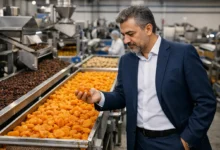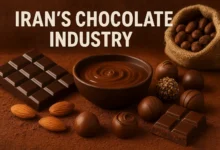Iranian Beverage Market: Facts vs Global Summaries
Debunking Drinktec: The True Landscape of Iran’s Drinks Market

One of the international sources that recently attempted to analyze Iran’s beverage market is the German platform Drinktec — a trade fair and content hub focused on global beverage and liquid food technologies. As part of its regional coverage, Drinktec published an article titled “The Beverage Industry in Iran: Between Booming Demand, Changing Consumption Patterns and Sanctions”, offering an introductory overview of Iran’s non-alcoholic drink market.
While the article succeeds in highlighting a few macro-level themes — such as Iran’s population density, sanctions, urbanization, and the traditional role of beverages like Doogh — its content falls short in several key areas. It presents generalized estimates (e.g., carbonated beverages account for 35% of sales), but lacks clarity on data sources, segmentation, and brand-level competition. Crucial segments such as youth-driven “new-generation” drinks or the economic impact of high inflation on consumer behavior are completely omitted.
However, this picture is painted with overly broad strokes. For instance:
-
No citations for actual sales volumes: Drinktec refers to per capita consumption figures and market share percentages, but doesn’t disclose how these figures were obtained or whether they represent formal retail sales, traditional outlets, or informal channels.
-
Lack of segmentation: Carbonated beverages are treated as a monolith, ignoring the vital distinctions between cola, lemon-lime, fruit-flavored sodas, and malt-based carbonated drinks — each with different audiences, growth rates, and pricing dynamics.
-
No brand-level analysis: While the article names major players such as Coca-Cola and Zamzam, it doesn’t delve into brand-specific market share, consumer perceptions, or competitive positioning — crucial factors for any market entrant or stakeholder.
-
No attention to price sensitivity or inflation effects: The role of inflation — which has exceeded 30% annually in recent years — is briefly mentioned but not analyzed in terms of how it impacts consumer choices, packaging formats, or regional distribution disparities.
-
No mention of youth-driven trends or new-generation beverages: Rapidly growing segments such as “new-age” drinks (e.g., Icey Monkey, TorshX) and sugar-free variants, which have reshaped demand patterns among Gen Z, are entirely absent.
These omissions make it difficult for investors, policymakers, and suppliers to make informed decisions based on the Drinktec summary alone.

How the Myindustry Report Fills the Gaps: Granular, Verified, and Actionable
Our article, Drink Industry in Iran: Market Trends & Opportunities, and its extended companion piece, Understanding Iranian Taste in Beverages, go far beyond surface-level analysis. Based on field studies, industry interviews, retail sampling, and direct consumer surveys conducted in 2024–2025, our report offers:
1. Quantified Sales Volumes and Market Values
Rather than rely on broad estimates, we provide:
-
Annual unit sales for key categories (e.g., 190 million cans of energy drinks sold annually)
-
Average retail prices and value projections for 2025
-
Realistic market size estimates: for example, energy drinks hold 1–1.5% of the market, not the inflated 5% assumed in external reports
2. Detailed Category Segmentation
We categorize Iran’s beverage market into 11 distinct segments, including:
-
Traditional herbal drinks (8–10%)
-
Tea and coffee (25% and 4–6%, respectively)
-
Packaged fruit juice (12–14%) and fresh juice (4–5%)
-
Carbonated drinks (20–22%) — sub-divided by flavor, format, and price tier
-
Dairy-based beverages (8–9%)
-
Bottled water (6–7%) and sparkling water (1%)
-
New-generation drinks (under 0.5%)
Each segment is explored not just by volume, but also by consumer profile, price elasticity, growth trajectory, and dominant distribution channels.
3. Brand-Level Insights
From Zamzam’s legacy to Sunich’s diversification strategy, from Hype’s dominance in the energy drink category to the emergence of Icey Monkey among Gen Z, we identify:
-
Market leaders and their approximate share
-
Pricing strategies
-
Demographic alignment
-
Competitive positioning and regional penetration
This allows stakeholders to map out partnership opportunities, assess acquisition potential, and benchmark performance.
4. Consumer Motivation and Behavior
Our field studies include direct responses from Iranian consumers about why they choose one drink over another. For example:
-
49% of energy drink buyers cite mental/physical boost as their top reason
-
Only 8% buy for flavor — a reversal from fruit juices, where taste is the primary driver
-
Doogh remains culturally embedded, but its price sensitivity has led to a 20% drop in consumption in some provinces
These insights help companies tailor marketing, packaging, and even product formulation to real-world behaviors.
Examples Where Drinktec Gets It Wrong — or Misses the Point
| Topic | Drinktec’s View | Myindustry’s Findings |
|---|---|---|
| Carbonated Drinks Share | 35% of market | Closer to 20–22%, segmented into colas, fruit-flavored sodas, and malt beverages |
| Doogh Consumption | Highlighted with no volume data | Doogh has dropped ~20% due to price hikes; dominant in rural areas |
| Energy Drinks | Growing fast, no detail | 190 million units/year, $76.8M market, dominated by Hype, Big Bear |
| Packaged Juice | Important segment | Packaged juice (12–14%) + fresh juice (4–5%) = nearly 20%, with health-driven subcategories growing |
| New-Gen Drinks | Not mentioned | Icey Monkey & TorshX driving trends among Gen Z; under 0.5% volume but high cultural relevance |
| Economic Impact | Mentions sanctions and inflation | Detailed analysis of inflation’s effect on packaging, format size, brand loyalty |
While reports like Drinktec’s are useful for raising awareness and offering introductory overviews, they are not sufficient for serious decision-making in Iran’s beverage sector. They typically:
-
Rely on outdated or unofficial data
-
Miss local dynamics (e.g., informal markets, price shocks, seasonal shifts)
-
Generalize consumer behavior
-
Omit emerging trends that matter to investors, distributors, and brand owners
For anyone planning market entry, investment, product localization, or partnership development in Iran, what’s needed is not just a map — but a GPS: granular, precise, and constantly updated.
The Case for Local Research: What Myindustry Consulting Group Offers
At Myindustry Consulting Group, we specialize in Iran’s consumer and industrial markets. Our research approach includes:
-
Retail & wholesale data sampling
-
Field interviews with sellers and buyers
-
Monthly tracking of price indices
-
Brand visibility audits across major provinces
-
Direct surveys with 2,000+ urban and rural consumers annually
This enables us to offer actionable reports, custom advisory, and product-specific insights to FMCG clients, retailers, and investors.
Our recent studies have informed:
-
Distribution strategy realignment for local beverage manufacturers
-
Product reformulation for health-conscious demographics
-
Brand repositioning for startups entering crowded segments
You can download our full reports, including charts, demographic breakdowns, and segment-specific pricing data, on our website.
Final Thoughts
Iran’s beverage market is rich with cultural depth, demographic complexity, and untapped potential — but it cannot be decoded by distant observers alone. Reports like Drinktec’s offer a starting point, but they often misrepresent the market’s real structure, exaggerate volume shares, or omit crucial brand and behavioral factors.
As our 2025 beverage market report demonstrates, localized, field-verified data is essential for making smart moves in Iran. Whether you’re a multinational brand or a regional distributor, the difference between “interesting” and “actionable” lies in the quality of your insight.
👉 Download the full Myindustry report here
👉 Read our full article on Iran’s drink industry here







